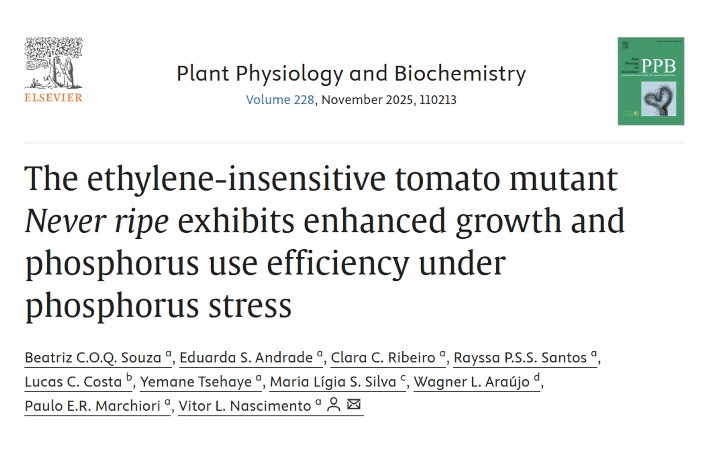The ethylene-insensitive tomato mutant Never ripe exhibits enhanced growth and phosphorus use efficiency under phosphorus stress
É com grande orgulho que compartilhamos a publicação de um artigo na revista Plant Physiology and Biochemistry. Parabéns aos autores por essa conquista!
Publicado em: 29/07/2025 às 16:02hs

Abstract
Phosphorus (P) is a macronutrient required as a structural and functional component of biomolecules; P homeostasis interacts with phytohormone signaling pathways, such as ethylene, leading to responses in plant growth and development. Tomato plants (Solanum lycopersicum L.) have been used as a model for physiological and biochemical studies, and the ethylene-insensitive mutant Never ripe (Nr) is useful for understanding how ethylene interferes and coordinates biological processes, including responses to nutritional stresses with P. Here we aimed to evaluate how the Nr plants respond to P stresses (absence – no P - and excess – 2× P), to understand how the crosstalk between ethylene signaling and P homeostasis works. For this, tomato plants of the wild type (WT) and Nr genotypes were submitted to fertigation with an adapted Hoagland solution in growth room conditions, two factors in a factorial arrangement, distributed in six treatments, two (genotypes) x three (P levels): (i) WT in P absence; (ii) WT in control; (iii) WT in P excess; (iv) Nr in P absence; (v) Nr in control; and (vi) Nr in P excess. Plant growth and yield, photosynthetic, biochemical, and nutritional parameters were quantified. The highest values of the biometric parameters were found mostly in Nr in all treatments, and fruit production was affected, being higher in the mutant than in WT in the P absence. Some photosynthetic parameters, such as CO2 assimilation and stomatal conductance, were higher in P absence for both genotypes. Nr plants showed lower levels of carbohydrates, increased amino acids and proteins, and better both P accumulation and efficiency. Nr plants also demonstrated higher vigor when exposed to P stresses, as verified by their highest biometric attributes. Increased levels of nitrogen compounds in Nr, especially proline, indicate that these plants have an intrinsic ability to accumulate these substances, might using them to better osmoregulate and resist P stress. These results demonstrate that ethylene perception plays an essential role in the signaling of P stresses, with the insensitive plants presenting a mitigation of the stress effects.
Acesse o artigo diretamente em https://doi.org/10.1016/j.plaphy.2025.110213
